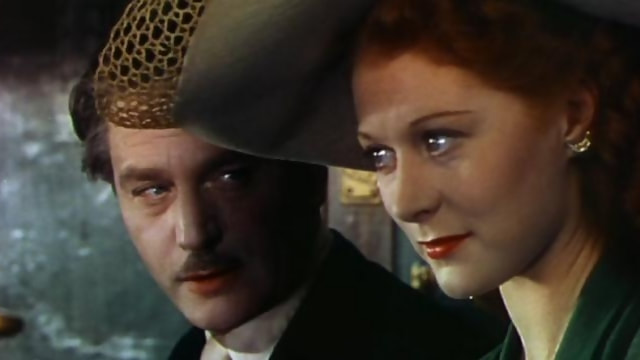 THE RED SHOES
THE RED SHOESFew fantasy films have been as admired and respected as The Red Shoes. Based on reputation alone I opted to buy the Blu-ray sight unseen. The Red Shoes simply blew me away, a visually overwhelming spectacle that is also an allegory on the struggle between the personal and professional lives. With excellent performances an a ballet sequence that leaves the viewer breathless, The Red Shoes is a true landmark in cinema (at least 'cinema' that does not involve talking trees and hunky extraterrestrial gods of war).
Aspiring composer Julian Craster (Marius Goring) and aspiring ballet prima donna Victoria Page (Moira Shearer), through separate means, find themselves in the heady world of the legendary Lermontov Ballet Company. Craster becomes an assistant music director and Vicky a member of the chorus.
This mad, chaotic but wonderful world is overseen by powerful impresario Boris Lermontov (Anton Walbrook), who rules this world without question. He sees the talents of Craster and Page and selects them for a new work based on Hans Christian Andersen's fairy tale The Red Shoes. The work continues, and in her debut Page and The Red Shoes is a sensation, just as Lermontov said it would be.
What Lermontov did not count on was that Craster and Page would fall in love. Lermontov sees that while they are still skilled, the essence of their work is to his mind mechanical, the true passion shifted from their craft to each other. Displeased, he puts it to them to choose, and they choose each other.
The ballet company continues and Craster does start finding success as a composer, though he does not have the rights to The Red Shoes as it belongs to Lermontov. Vicky, however, has struggled in her own career, and a 'chance' encounter with Lermontov gives him a chance to tempt her with a comeback in The Red Shoes, which he has proclaimed would be danced by no other. She agrees, but Craster has rushed to Monte Carlo to convince her not to, having given up his own debut. The struggle within Vicky culminates in a shocking turn, bringing tragedy to them all.
The highlight in The Red Shoes is the actual ballet number, a fifteen minute sequence that slips from a traditional ballet number to a cinematic fantasia that not only is visually arresting but downright jaw-dropping. I had to pause the film after the number, overwhelmed and knocked out by the entire spectacle. You had Jack Cardiff's cinematography, which takes your breath away in the lush and vibrant uses of color.
You had director Emeric Pressburger and Michael Powell pushing for this daring visual and artistic vision, going all-in on something that blends reality and fantasy, a number that is a heightened unreality that is more than visually arresting as I previously said. It is downright extraordinary. The closest I can find to compare the Red Shoes ballet sequence in any film is the finale to An American in Paris, and the latter definitely pales to the former. I wouldn't be surprised if An American in Paris' Vincente Minnelli and Gene Kelly didn't use the dance number as inspiration for their own ballet sequence. As good as the closing number in An American in Paris is (and to my mind, one of two parts of the film that I thought well of), The Red Shoes towers over the whole film.
You see Powell and Pressburger not only deciding they were going to create art but succeeding at it.
It is not just the visuals where The Red Shoes succeeds. You see that in other aspects too. Shearer was a dancer who could act, and given this was her acting debut you would not think she had not acted before. Her performance is exceptional, going from almost haughty to plucky to lovelorn and ultimately doomed.
 Walbrook too was exceptional as Lermontov, the producer who sees the visions of art and won't bend to anything else. He does not play him as evil and in his own way Lermontov is passionate, but his passion is for his art. Everything must be part of his vision, whether it is letting a composer essentially steal music from a pupil to driving lovers apart. I would say that Goring was probably the weakest of the three, but he does well enough to not think about it.
Walbrook too was exceptional as Lermontov, the producer who sees the visions of art and won't bend to anything else. He does not play him as evil and in his own way Lermontov is passionate, but his passion is for his art. Everything must be part of his vision, whether it is letting a composer essentially steal music from a pupil to driving lovers apart. I would say that Goring was probably the weakest of the three, but he does well enough to not think about it.The Red Shoes gives us a surprisingly loving and almost documentary-like look into the creative process, that to create something so splendid takes great work, long hours and heartbreak too. All those who work in this dance company work to do their very best and are very skilled, and benefit from Lermantov's sharp eye and shrewd manner. However, they have a life separate from the dance, which Lermantov and Vicky do not.
The Red Shoes is a love letter to and a warning on the creative process, both on how much to give to your work and give to your own self. That struggle, so brilliantly captured in the film, along with some sensational numbers, makes The Red Shoes one of the hallmarks of cinema.
DECISION: A+

No comments:
Post a Comment
Views are always welcome, but I would ask that no vulgarity be used. Any posts that contain foul language or are bigoted in any way will not be posted.
Thank you.